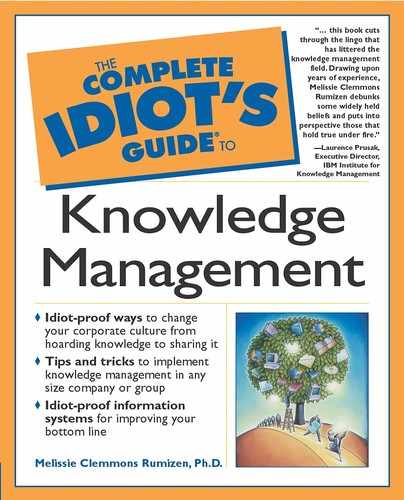
Chapter 5
Developing a Strategy
In This Chapter
▶ Elements of a good strategy
▶ Combining knowledge management strategy and corporate strategy
▶ Finding an executive sponsor
▶ Defining knowledge management in your organization
▶ Choosing between one big strategy or multiple projects
▶ Focusing on people
Knowledge management: The evangelists have sold you on the concept. Now you want to go home and do it. Do what? There are so many options, so many things you could do. They all seem worthwhile. Picking one, two, or even three is impossible.
Crafting a KM strategy is tough. There are a lot of decisions to make. There are a lot of questions without a right answer. You have to be creative. You need to rely on your judgment. If you are new to the field, it may even seem unfair that you have to make such tough decisions before you feel ready.
But there are road maps you can follow to make it easier. A road map won’t guarantee that you’ll get there, but it will give you a plan to follow. In this chapter, we will look at some of the initial steps in crafting a knowledge management strategy.
Fundamentals of a Good KM Strategy
A good strategy tells you what to do. It gives a plan of action. It says what should be accomplished and how long it will take. A good strategy also looks at what investments are needed and in what areas. To get you started, here are some things to consider:
▶ Supporting KM infrastructure—the people needed
▶ Expanding information technology infrastructure
▶ Describing corporate culture
▶ Developing specific approaches for carrying out the strategy, like the learning before/during/ after approach at BP
▶ Instituting measures

Know These
A corporate culture is defined as the unspoken but shared assumptions that guide the daily behavior of people in organizations. It is not only what we do; it is the beliefs underlying what we do—the whys. It is complex and hard to puzzle out.

Know Nos
One of the never-spoken secrets in knowledge management is that usually there isn’t just one single, perfect answer for what the best strategy is for any organization. Don’t drive yourself crazy trying to figure out what is the “best” for you. Settle for something good with demonstrable results. Learn as you go along, and change the strategy if you need to. Don’t lock yourself in.
When considering strategy, keep in mind that one size doesn’t fit all. What is the perfect strategy for another company could be disastrous for yours. Like a best practice, a strategy must be best for you. You must tailor your KM strategy to your organization. It needs to fit like a glove.
Tailoring KM Strategy for Your Organization
So, whom are you tailoring the strategy for? Ask some key questions about your organization:
▶ What is the nature of your business? What do you do?
▶ What is your vision?
▶ What are your goals?
▶ How do you plan to achieve your goals?
▶ What is your organization’s current business environment?
▶ What is your industry? What affects it? What is the environment for your industry?
As nifty as KM is, the job of your KM strategy is to help the organization achieve its strategy and goals. Never forget that. Your KM strategy must be firmly rooted in the context of your organizational strategy.
To your surprise, the KM conversation may help uncover a need to change the corporate strategy. Perhaps a lack in strategic capabilities was overlooked. Perhaps the company has some strengths that haven’t been considered. You may even wind up helping to reshape the company’s strategy and vision. That can happen when you start to figure out what the company and its people actually know how to do.
Developing new capabilities through knowledge management also changes the corporate equation. As new things become possible, this can also motivate the need to change the overall organizational strategy. This happened at McKinsey, where a community of practice recommended a new strategic direction for this major management consulting firm.
If you are below corporate level, in a division or other unit, you need to support both corporate and your level’s goals. In the HPC example, innovation is a key driver for HPC. So the HPC knowledge management strategy supports innovation. The HPC strategy also supports the goals of HPC itself.

Know How
Authors Michael Tracey and Fred Wiersma give three ways of describing most organizational strategies, which they call market disciplines:
▶ Operational excellence is giving the best value, produced internally by reducing costs and increasing efficiency. This underlies Chevron’s strategic drive to reduce operating costs.
▶ Customer intimacy means delivering tailored products and services. One example is Airborne Express.
▶ Product leadership has a focus on innovation, trusting that the best and newest will dominate the market. This is the strategy of Intel.
In The Discipline of Market Leaders: Choose Your Customers, Narrow Your Focus, Dominate Your Market (Addison-Wesley, 1995), they argue that top-performing organizations focus on only one. The question for you is what knowledge is needed for the discipline your organization is following.
Talk to key people throughout your organization about strategy and goals. Look at what various units and functions are doing. Discuss plans for the future. Bring up factors that influence reaching goals. Clearly define the end point, where you want to end up.
Look at Your Starting Point
Bore in on any gaps that could prevent the organization from reaching its strategic or its knowledge management goals. Look for pain as you talk to people. I know that looking for pain may sound ghoulish to you (and a possibility for another funky corporate title: Knowledge Management Ghoul). Okay, you can call it looking for problems instead. But whether you call it looking for organizational pain or problems, it shows there are opportunities for improvement. And that’s your chance to provide ideas for taking action that can result in a big win to the organization and a big win for proving the value of KM.

Didn’t Know
In July 1988 there was an explosion and fire on an oil platform in the North Sea. A supervisor on the rig, Andy Mochan, woke up when he heard the explosion and the alarms. He ran to the edge of the rig and jumped in the North Sea to water ablaze from oil and debris. The water was so cold that it could have killed him within 20 minutes, but as he later said, “It was jump or fry.” In organizations, a burning platform is an issue that dictates change because not changing is unthinkable.
The flip side of the problem coin is a significant opportunity. This isn’t a chance to fix something, but a chance to do something new. Some possibilities are
▶ Introduction of a new business line or venture.
▶ A change to open up a new market.
▶ Restructuring of an organizational unit.
▶ Another big program, such as implementing Six Sigma.
▶ Building a new facility like a plant.
▶ Mergers, acquisitions, or joint ventures.
▶ Big changes in senior leadership, perhaps a new CEO.
No matter what they are, opportunities give you an opening to use knowledge to make a difference. HPC did this when it expanded the capabilities of its North American SAP practice.
Another way to look at your starting point is to assess your organization’s knowledge, searching for gaps in critical knowledge. HPC did this by asking the ultimate judges, the customers. I also suggest talking to suppliers. They, too, know where knowledge potholes are. They drive into them all the time.
Ask both customers and suppliers what it’s like to do business with you. Do they get the knowledge they need from you to partner effectively with you? Can they find the people and information in your organization they need when they need it?
One of the most telling comments I have heard from a customer once was that our organization was like a box with many compartments. The problem was that she didn’t know where to look in the box for what she needed. Neither did our associates. In the end it didn’t matter what we knew—she couldn’t find what she needed. Using knowledge maps can help you find gaps in critical knowledge. They can help you establish a baseline and identify
▶ What information is in your organization.
▶ How it can be found.
▶ What expertise is within your organization and where.
▶ What important expertise is outside your organization and where it is.
organization and where it is.

Know How
Looking at internal and external knowledge may run you head-on into difficulties. One way organizations are different is whether or not they value internal or external knowledge. Some can be described as xenophobic, rejecting outside knowledge. Others go the other way, only valuing external knowledge. Some can do both. Be prepared for this as a potential roadblock. But then, insist on looking both ways.
▶ How to get access to it.
▶ What the best sources of information are, both internal and external.
Once you have mapped the knowledge, you should understand the following:
▶ What critical actions a unit must take.
▶ What decisions people in that unit must make to do their work.
▶ What information they need to make those decisions and do their work. That information may be explicit, codified in various ways. Or that information may be tacit, coming from other people.
Using knowledge mapping was a key process for the solution groups at HPC, too. It helped them focus on what the important knowledge was, as well as ways of managing it.
Advantages of an Executive Sponsor
Undertaking a knowledge management initiative requires resources. An important question becomes: Where do those resources come from and who will pay for them? The first thing that needs to be paid for is your own salary if you are engaged in this initiative. Most of us do not have the position needed to fund the people and resources involved in a KM project. Find and cherish an executive sponsor. (I used to make chocolate chip cookies for one.)
Funding isn’t all your sponsor will provide. A sponsor can open doors for you, getting you in to see other senior managers who otherwise wouldn’t give you the time of day. At upper-level meetings a sponsor can fight for the cause, carrying the KM banner. In chance meetings a sponsor can persuade and convince.
Connected at the highest levels and canny in the ways of the organization, they can
▶ Coach you on your communication strategy.
▶ Give you a better understanding of the big picture.
▶ Ease your attempts to get funding.
▶ Help you plan your overall strategy.
▶ Encourage you and tell you that what you are doing is important.
Finding one, though, isn’t always easy. I was lucky enough to have one call me up and volunteer. (I then danced down the hallways to tell my partner as if I was a bad actor in a musical.)

Know How
Start as much as you can on strengths. For example, one way HPC could have pitched the SAP project was to praise the formidable expertise already in a small group in HPC. Then it could have moved to the need to expand the strength across North America.
On the other hand, my partner and I helped that luck along. We had lobbied to present to the CEO and the Board a KM award (of sorts) that we had won. It gave us a platform for talking about KM. The eventual executive sponsor was there. Turned out that he already believed in KM. He hadn’t known anyone was working on it as he was new in town.
It was the difference between night and day for us. Doors suddenly opened up everywhere. He even got us in the door to present to our CEO’s boss. He kept his promise to us that he would not rest until the CEO, too, believed.
Consider the Tinker Bell factor when looking for a sponsor. Remember in the story Peter Pan when Tinker Bell is dying and everyone who believes is asked to clap his or her hands? Not everyone out there will clap his or her hands for knowledge management.
Some, often intuitively, do understand that knowledge is the key to success for their organizations. Others demand that you lay out detailed specifications, guaranteed returns, and the exact payoff for their investment. But no matter what numbers you give them, they just don’t get it.
Old hands in the KM field look for the Tinker Bell factor. If they clap at least once, you usually have a chance to explain, maybe persuade. If not, you’re wasting your time.
This was a hard lesson for me to learn. But I have since heard many of my peers talk about the need to be realistic. A mind may be a terrible thing to waste, but wasting your time on a closed mind is also terrible. Your sponsor has to understand KM and believe in its value. There is no substitute for belief.
Also look for a sponsor who is respected by his or her peers. You don’t want the corporate loony sponsoring your cause. You want someone who tackles the tough jobs and delivers the goods, the E.F. Hutton type to whom others listen. Also, you might look for someone who is characterized as innovative, a little bit in front of everyone else. Such people are known for blazing the right trail to follow.
I realize this sounds as tough as finding a date that your parents and your friends approve of, but actually it’s worse. Looking for a sponsor is like looking for a spouse. It is critically important to select the right one.
Developing the KM Pitch
Face it, the term “knowledge management” on its lonesome isn’t sexy. No advertising company would ever recommend it for a marketing campaign. It does not communicate the concept. You need to put the words with it that will make sense for your organization.

Know Nos
Many think the ideal sponsor is your CEO. Maybe, maybe not. Your CEO may not have the right characteristics to lead change, or might not be the best choice in your culture. The mistake I see most often is people assuming that having the CEO for a sponsor will make everything happen magically. Despite the advantages of CEO support, this is dead wrong.

Know How
People are going to ask you if there is something short they can read. Xerox solved this by putting together a pocket-sized booklet that included a definition of KM, knowledge-sharing principles, and some of the Xerox approaches. I also suggest using the little book Knowledge Management: A Guide for Your Journey to Best-Practice Processes from the American Productivity and Quality Center’s Passport to Success series.
Many people start is by discussing what knowledge management is and what it is not. I sat in once on a session of senior managers who brainstormed the what is and what isn’t. It was time-consuming and illuminating. Granted, it would have been easier for me to prance over to the whiteboard, write down “the” definition, and wait for rapturous agreement (and wait, and wait … ). But the value was in the discussion. Then you can move to forming a shared definition that has meaning for your organization.

Know Nos
This goes back to the concept of shared vision from The Fifth Discipline. If you are leading or participating in a KM effort, your job isn’t to give the perfect, expert definition. Your job is to help build organizational consensus on what KM is and what value it will bring.

Know How
One way to deliver pizzazz and help develop a shared vision is a well-done video montage. Recently I watched one created by Erick Thompson of the Saint Paul Companies (a large insurance corporation). It had emotional impact. It made us think. It helped us to talk about what knowledge and knowledge management are. It was a springboard for a knowledge vision.
Going back to the elevator speech (explaining something in about 30 seconds), you also need to include in the definition a brief synopsis of how you will accomplish KM. Lay out concrete actions you plan to take. Name people who will be involved. Describe the timelines you have. Don’t worry about whether or not everything is cast in stone. Emphasize the benefits and deliverables. Doing KM is going to do great things for your organization. Always explain how it will benefit people, how it will make their lives easier.
Once you’ve come to an agreement on your definition of knowledge management in your organization KM, developed your elevator speech, and come up with your vision, then put together a marketing presentation. If you need to, talk to the marketing people or a salesperson in your organization. Ditch the elaborate charts. Keep lots of white space—in other words, make sure you don’t fill your PowerPoint slides with lots of little words. Balance clarity with some pizzazz. You’ve got to have as much sizzle as your culture allows. You want people to be as excited about how KM will help them as you are.
The process of putting together a presentation will help you to clarify your definition, the elevator speech, and your vision. If you can’t explain it simply, you haven’t got it yet.
One Big Strategy or Multiple Projects?
I think of this as the “big gorilla” or “lots of monkeys” question. The issue is whether or not you want to put together a strategy that sweeps across your entire organization, impacting many processes. With the use of communities and project snapshots, HPC went for the big gorilla. So did BP with its learning before/during/ after approach. Both organizations intended to transform the way the entire organization worked. That’s impact.
It’s a lot harder to work with a big gorilla. You have a large scope and thus a large implementation. You have more to worry about. However, the payoff is also potentially great. Your other option is identifying smaller, more isolated projects in specific areas. This is a surgical approach. These have fewer headaches. They are easier to manage and easier to focus on.
HPC did this with its knowledge mapping approach. As it turned out, knowledge mapping was best suited for its solutions groups, not all of HPC. It still had good results and a good impact. It just didn’t reach across all of HPC as the other approaches did.
The answer for your company depends upon your organizational strategies and gaps. If the payoff is large enough, a little monkey is as good as a big gorilla.
Connecting People or Writing Things Down?
In the early days of the KM frontier, many efforts revolved around capturing “the knowledge.” Databases were built—enormous piles of data and information. Computer storage capacity increased to house it. Because information technology was needed for search, data mining, and retrieval, IT became king.
A colleague of mine tells the story of a large, well-respected firm that built a best-practices database. Millions were spent on building the best best-practices database money could buy. The structure was impeccable. The content was a marvel. The gold-mine then was made easily accessible to everyone.
And no one used it. No one had stopped to involve the users. Most importantly, no one had asked what knowledge was important for the company to reach its goals. No one had asked what value customers expected.
This mania to codify explicit knowledge has happened over and over again in different companies. It isn’t necessarily a bad idea. If you have processes that are repeated over and over again across the globe, codifying best practices can have a big payoff. If the work in your organization largely depends upon explicit knowledge, by all means write it down and make it available.
The key issue here is use and reuse of explicit knowledge. If that’s important for your organization, then by all means go after it. It will require a heavy investment in information technology to codify, store, and disseminate the explicit knowledge. If this is important to you, then you will live or die by your information technology as well as the goodness of the content. Also expect to invest heavily in the publishing process—writing, coordinating, editing, and maintaining the content. You are developing the equivalent of books for a huge library.
So think carefully about it. Dorothy Leonard-Barton, author of Wellsprings of Knowledge (Harvard Business School Press, 1998), believes that 80 percent of the important knowledge in an organization is tacit, and that beast resists codification. I believe that as well.
In contrast, a personalization strategy focuses on linking the source of tacit knowledge: people. You see approaches like networks, communities of practice, and yellow pages. The key word in this approach is “connecting.”
You will still need to invest in information technology, but the emphasis will be on technology that connects people to people. The goal is to facilitate exchanges through technologies like threaded discussion and videoconferencing.

Know How
Hansen, Nohria, and Tierney detailed their study findings and conclusions in a Harvard Business Review article titled “What’s Your Strategy for Managing Knowledge?” It was published in the March-April 1999 issue. It sparked debate in the KM community, a debate that continues.
In actuality, it is not a case of one or the other. A KM program focused on explicit knowledge will have some people connections. A KM program focused on connecting people also will have to address explicit knowledge needed by the people.
In an extensive study in the late 1990s, professors Morton Hansen, Nitin Nohria, and Thomas Tierney found that most organizations usually had a mix. If they concentrated on codification, they had a mix of 80 percent for codification with 20 percent for connecting. Companies focusing on connecting had the opposite mix: 80 percent on connecting, 20 percent on codification.
This is another question with no right answer. Your company will have to use its own judgment as to what is best.
The Least You Need to Know
▶ A good KM strategy is a plan of action that describes what needs to be done, says what needs to be accomplished, is linked to the strategy of the organization, and gives a timeline.
▶ An executive sponsor is a critical success factor for a KM program.
▶ You need to define what KM means for your organization.
▶ You need to develop a vision for KM.
▶ One issue you need to consider when putting together a strategy is whether or not you want a strategy that spans the organization or focuses on smaller areas.
▶ Another issue you need to consider is whether to concentrate on explicit or tacit knowledge. Concentrating on explicit knowledge leads you to codify. Concentrating on tacit knowledge leads you to connect people.
..................Content has been hidden....................
You can't read the all page of ebook, please click here login for view all page.
